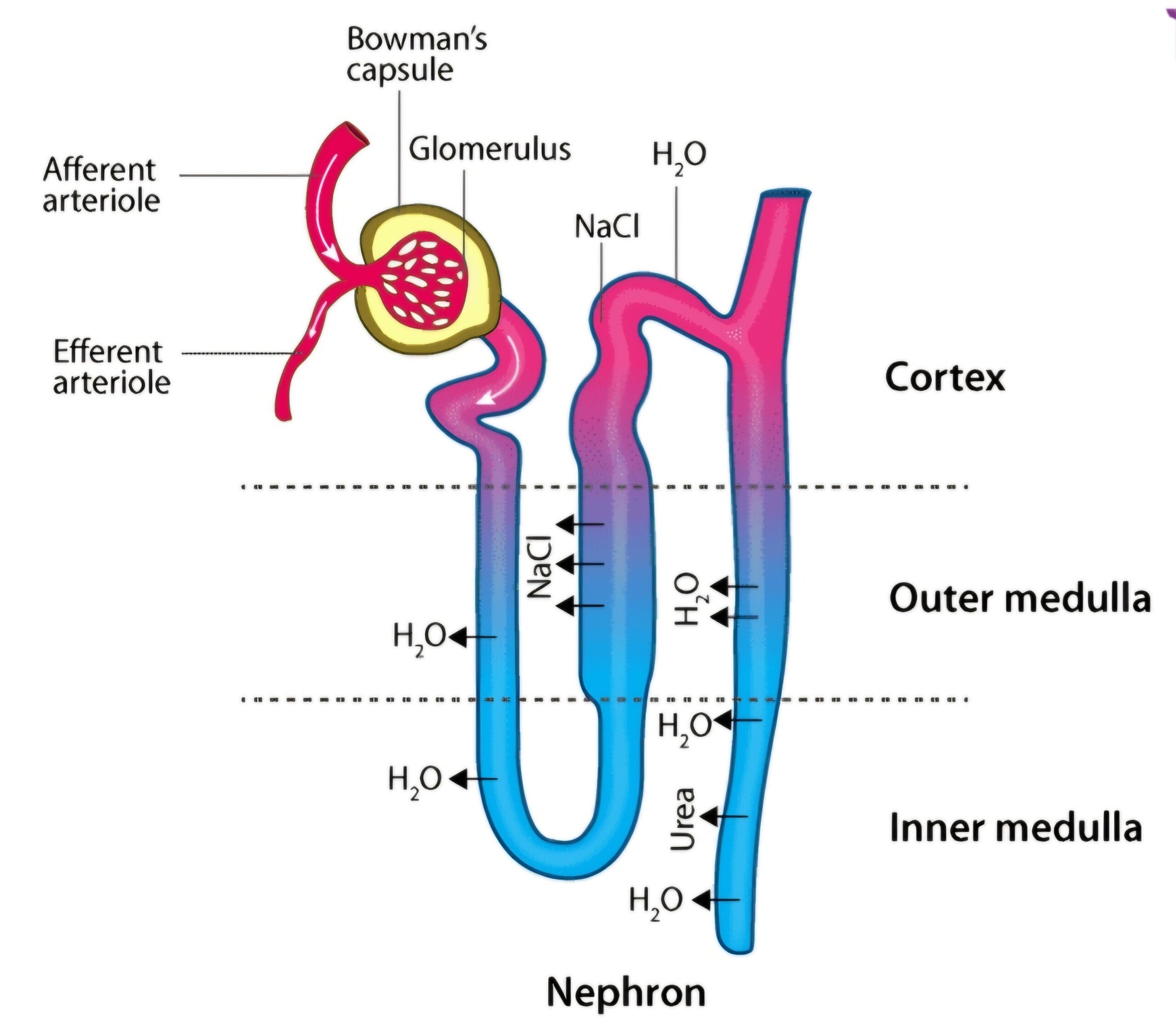Describe the structure and functioning of nephrons.

Nephrons are the functional units of the kidney, responsible for filtering blood and producing urine. They consist of a renal corpuscle (glomerulus and Bowman’s capsule) and a renal tubule, which includes the proximal convoluted tubule, loop of Henle, distal convoluted tubule, and collecting duct. Their main function is to remove waste products from the blood, regulate blood volume and pressure, and maintain electrolyte balance.
Structure:
Renal Corpuscle:
This is where blood filtration begins. It includes:
Glomerulus: A network of capillaries where filtration occurs.
Bowman’s Capsule: A cup-shaped structure that surrounds the glomerulus, collecting the filtered fluid (filtrate).
Renal Tubule:
This long, coiled tube processes the filtrate. It consists of:
Proximal Convoluted Tubule: Reabsorbs most of the filtrate’s water, electrolytes, and nutrients.
Loop of Henle: A U-shaped structure that further regulates water and salt balance.
Distal Convoluted Tubule: Reabsorbs more water and electrolytes, under hormonal control.
Collecting Duct: Collects the final filtrate, which is now urine, from multiple nephrons.
Functioning:
1. Filtration:
Blood flows through the glomerulus, and small molecules, water, and solutes are filtered out of the blood and into Bowman’s capsule, forming the filtrate.
2. Reabsorption:
As the filtrate passes through the renal tubule, valuable substances like water, glucose, amino acids, and salts are reabsorbed back into the bloodstream.
3. Secretion:
The renal tubule can also secrete substances into the filtrate, further modifying its composition.
4. Excretion:
The remaining filtrate, now urine, is collected in the collecting duct and excreted from the body.
In essence, nephrons act as miniature filtration and purification systems for the blood, ensuring the body’s fluid and electrolyte balance and removing waste products.
The nephron is the functional unit of the kidney, responsible for filtering waste and excess fluids from the blood. Here’s a detailed overview of its structure and function:
Structure of the Nephron
1. *Renal corpuscle*: The nephron begins with a renal corpuscle, which consists of a glomerulus (a tuft of capillaries) surrounded by a Bowman’s capsule.
2. *Proximal convoluted tubule (PCT)*: The renal corpuscle is followed by the PCT, a winding tube that reabsorbs nutrients, ions, and water from the filtrate.
3. *Loop of Henle*: The PCT is connected to the loop of Henle, a U-shaped tube that helps regulate electrolyte balance and concentrate the urine.
4. *Distal convoluted tubule (DCT)*: The loop of Henle is followed by the DCT, which further regulates electrolyte balance and pH.
5. *Collecting duct*: The DCT empties into the collecting duct, which collects urine from multiple nephrons and helps regulate water reabsorption.
Function of the Nephron
1. *Filtration*: The glomerulus filters the blood, removing waste products and excess fluids.
2. *Reabsorption*: The PCT and DCT reabsorb essential nutrients, ions, and water from the filtrate.
3. *Secretion*: The DCT and collecting duct secrete waste products, such as urea, and excess ions.
4. *Regulation of electrolyte balance*: The loop of Henle and DCT help regulate electrolyte balance by reabsorbing or secreting ions.
5. *Regulation of pH*: The DCT and collecting duct help regulate pH by secreting or reabsorbing hydrogen ions.
6. *Concentration of urine*: The loop of Henle and collecting duct help concentrate the urine by reabsorbing water.
Importance of the Nephron
1. *Waste removal*: The nephron helps remove waste products from the blood.
2. *Fluid balance*: The nephron regulates fluid balance by adjusting the amount of water reabsorbed.
3. *Electrolyte balance*: The nephron helps maintain electrolyte balance by regulating the reabsorption and secretion of ions.
4. *Acid-base balance*: The nephron helps regulate acid-base balance by secreting or reabsorbing hydrogen ion

Nephrons are the functional units of the kidney, responsible for filtering blood and producing urine. They consist of a renal corpuscle (Bowman’s capsule and glomerulus) and a renal tubule (proximal convoluted tubule, loop of Henle, distal convoluted tubule, and collecting duct), all working together to remove waste and regulate fluid and electrolyte balance.
Structure of a Nephron:
1. Renal Corpuscle:
Bowman’s Capsule: A cup-shaped structure that surrounds the glomerulus, collecting the initial filtrate.
Glomerulus: A network of capillaries where blood filtration occurs, driven by blood pressure.
2. Renal Tubule:
Proximal Convoluted Tubule (PCT): A coiled tube where most reabsorption of water, nutrients, and ions back into the bloodstream occurs.
Loop of Henle: A U-shaped structure crucial for establishing a concentration gradient in the kidney medulla, facilitating water reabsorption.
Descending Limb: Permeable to water, allowing water to move out into the medulla.
Ascending Limb: Impermeable to water, but actively transports ions out, further concentrating the filtrate.
Distal Convoluted Tubule (DCT): Another coiled tube involved in the final adjustments to filtrate composition, including water and ion reabsorption, influenced by hormones.
Collecting Duct: A duct that collects urine from multiple nephrons and transports it to the renal pelvis.
Functioning of a Nephron:
1. Filtration:
Blood enters the glomerulus, and water, electrolytes, glucose, and other small molecules are filtered into Bowman’s capsule, forming the initial filtrate.
2. Reabsorption:
As the filtrate moves through the renal tubule, the majority of water, glucose, amino acids, and ions are reabsorbed back into the bloodstream through the PCT and other parts of the tubule.
3. Secretion:
The nephron also secretes substances from the blood into the filtrate, such as hydrogen ions, potassium, and certain drugs.
4. Excretion:
The remaining filtrate, now called urine, is excreted through the collecting duct, ureter, and bladder.
Key Functions:
Waste Removal:
Eliminates metabolic wastes (urea, uric acid, creatinine) from the blood.
Fluid and Electrolyte Balance:
Regulates the concentration of water, sodium, potassium, and other electrolytes in the body.
Hormone Regulation:
Influenced by hormones like ADH (antidiuretic hormone) and aldosterone, which regulate water and sodium reabsorption.
Blood Pressure Regulation:
Plays a role in blood pressure regulation through its influence on blood volume and sodium concentration.